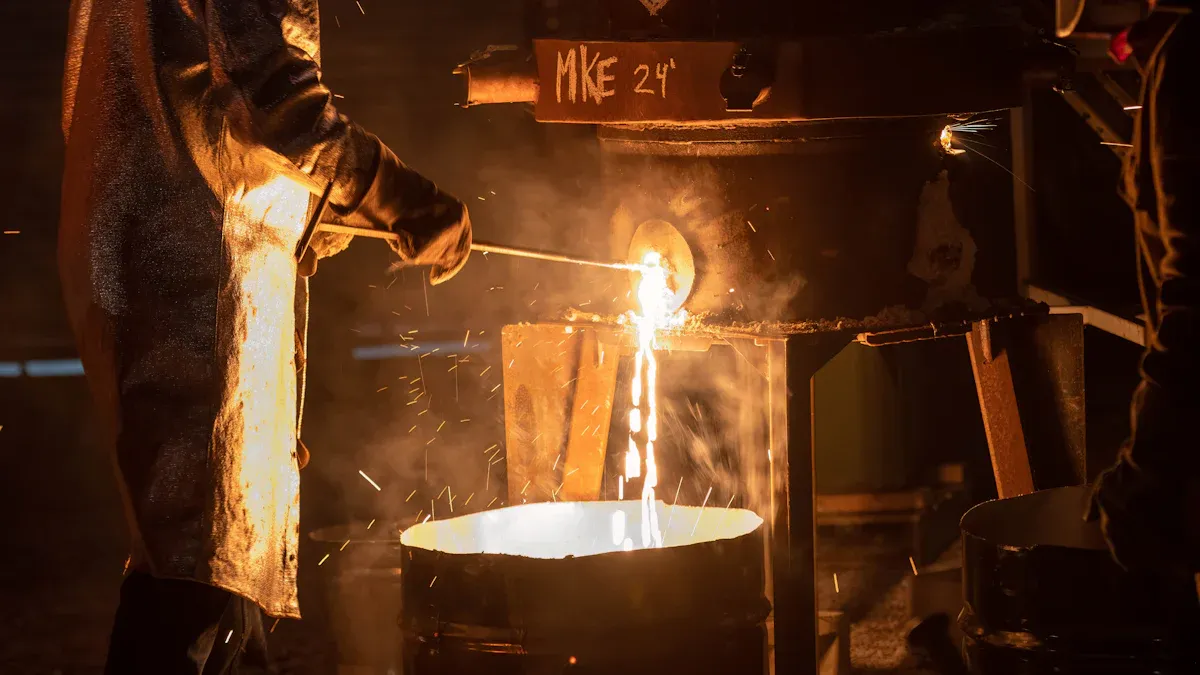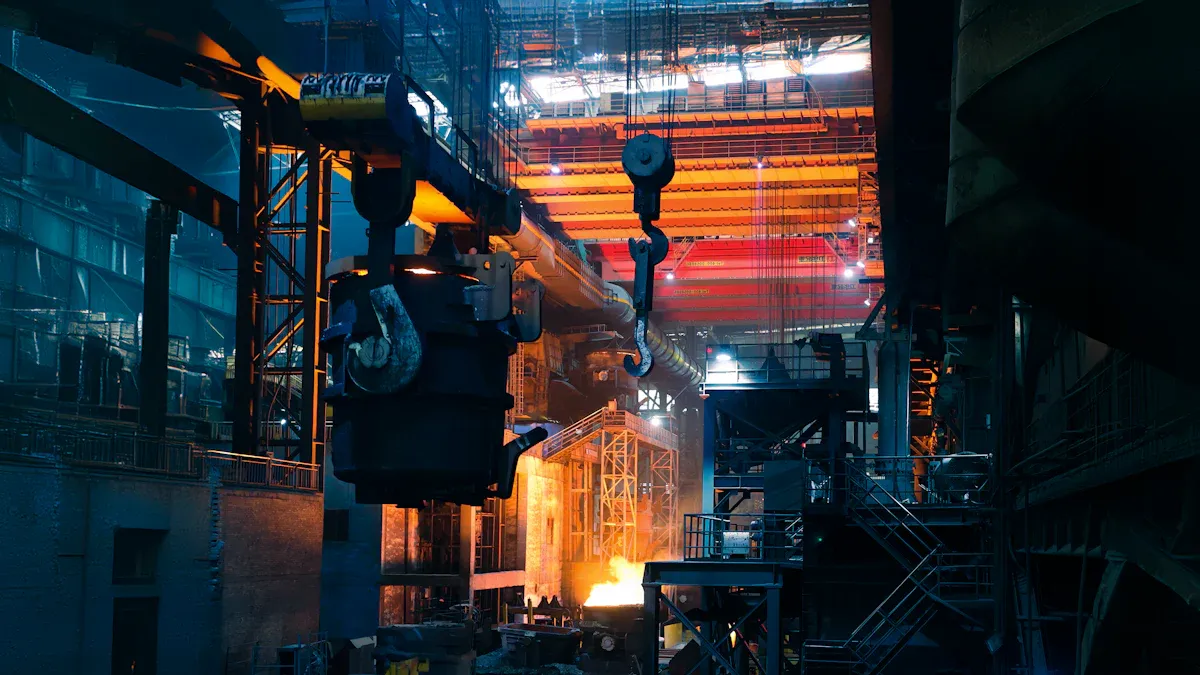How Semi-solid Casting Works: A Simple Guide

Semi-solid casting uses partly melted metal to make strong parts. In this method, the metal is heated until it’s not fully solid or liquid. This helps it flow easily into molds. This special method improves accuracy and lowers mistakes in the final product.
You might ask how this makes manufacturing better. Here’s why:
The metal fills the mold much faster, up to 3.5 m/sec for some alloys. This is seven times quicker than fully liquid aluminum.
There is very little air trapped inside, making the parts stronger and longer-lasting.
The heat used is almost half as much as older methods. This makes tools last two to five times longer.
By being fast, accurate, and strong, semi-solid casting changes how parts are made.
What is Semi-solid Casting?

Definition and Unique Characteristics
Semi-solid casting is a new way to make metal parts. It uses metal that is partly melted, not fully solid or liquid. This state, called "slurry," helps the metal flow easily into molds. It also keeps the metal strong while shaping it.
This method makes parts with better accuracy and smooth surfaces. It traps less air, which makes the parts stronger and last longer. The partly melted metal also moves calmly into molds, improving the final product's quality.
Experts have studied how this process works with different metals. For example, alloys like AlSi7Cu3Mg and EN AW-2014 show how temperature and solid levels affect strength. These studies show why careful control is important in semi-solid casting.
Differences from Traditional Casting Methods
Semi-solid casting is different from older casting methods. It uses less heat because the metal isn’t fully melted. This saves energy and lowers costs. Less heat also means molds last longer since they don’t get as worn out.
The parts made with semi-solid casting are better quality. Older methods often make parts with more air bubbles and uneven structures. Semi-solid casting creates stronger parts with smoother surfaces. For example, tests on thixoformed A356 alloy show it’s harder and more even than gravity-cast alloys.
This process is also simpler. It cuts down on steps, saving time and money. Industries like car and airplane manufacturing prefer it for its accuracy and efficiency.
Technical Processes in Semi-solid Casting
Material Preparation for Semi-solid Casting
To prepare materials, you must control temperature and composition carefully. The metal is heated until it’s partly melted but still has solid bits. This "slurry" helps the metal flow smoothly into molds during casting.
Scientists test and check this preparation process to ensure it works well. For example, they try different conditions, like changing gel amounts or ingredient strength. These tests make sure the method is reliable for making metal parts.
Rheocasting and Thixocasting Methods
There are two main ways to do semi-solid casting: rheocasting and thixocasting. Rheocasting makes the slurry straight from melted metal. Thixocasting uses pre-made metal pieces that are reheated to a semi-solid state.
Rheocasting is great for saving time and energy. It skips extra steps by forming parts directly from melted metal. Thixocasting gives better control over the metal’s structure. It’s useful for high-tech industries like airplanes and medical tools.
Both methods are improved through research. Studies show rheocasting fills molds faster. Thixocasting makes parts with smoother surfaces.
Mold Filling and Solidification Process
Filling molds and letting the metal harden is very important. The slurry flows calmly into molds, unlike fully liquid metal. This reduces air bubbles and makes stronger, longer-lasting parts.
Books like ASM Handbook Volume 15 explain how to improve mold filling and hardening. They show how semi-solid casting creates even metal structures. By controlling cooling, you can make parts with steady quality.
This process is key for making metal parts. It’s precise and efficient, which is why many industries use it to save money and get reliable results.
Advantages of Semi-solid Casting
Better Precision and Smooth Surfaces
Semi-solid casting is very precise. The partly melted metal flows easily into molds. This creates parts with clear details and smooth surfaces. It avoids problems like rough edges or uneven textures seen in older methods.
This precision is important for industries like airplanes and electronics. For instance, studies show thixocasting makes smoother parts than older techniques. This makes semi-solid casting great for jobs needing accuracy and good looks.
Fewer Flaws and Stronger Parts
Semi-solid casting lowers flaws in finished parts. The controlled flow stops air from getting trapped. This makes the parts stronger and last longer.
A study on risers shows how semi-solid casting reduces flaws. The table below explains how spherical risers improve results:
Riser Type | Yield Gain (%) | Riser Neck Size Cut (%) | Riser-Pipe Safety Height Gain (%) |
|---|---|---|---|
Spherical Riser | 45 | 77 | 18 |
Cylindrical Riser | N/A | N/A | N/A |
This proves semi-solid casting makes reliable parts. You can count on it for strong, long-lasting products.
Saves Energy and Costs
Semi-solid casting uses less heat than older methods. The metal is only partly melted, saving energy. This also makes molds and tools last longer, cutting costs.
Older methods use more energy and wear out tools faster. Semi-solid casting is cheaper and better for the environment. Research shows it lowers costs while keeping high quality.
Using semi-solid casting saves money without losing quality. It’s a smart choice for industries wanting to improve production.
Applications of Semi-solid Casting
Automotive and Aerospace Industries
Semi-solid casting is common in cars and airplanes. It makes lightweight and strong parts for these industries. Car makers use it for engine blocks, suspension parts, and transmission cases. In airplanes, it helps make strong and precise parts for the structure.
Semi-solid casting creates a globular metal structure. This is better than the dendritic structure in older methods.
Here’s a table showing car parts made with semi-solid casting:
Component | Benefits of Semi-solid Casting |
|---|---|
Engine Blocks | Lightweight and durable |
Suspension Components | Stronger and more accurate |
Transmission Housings | Better size accuracy |
This method improves performance and reliability, making it popular in these fields.
Electronics and Consumer Products
Semi-solid casting is important for electronics and gadgets. It helps make small, high-quality devices. This method allows detailed designs with smooth surfaces.
Electronics need precise and high-quality parts, so this method is used.
It reduces shrinking and improves size accuracy, great for tiny parts.
Scientists in China use machine learning to check pressure during casting. This improves quality for advanced parts.
From phone cases to laptop frames, this process ensures strength and accuracy.
Medical Devices and Equipment
In healthcare, semi-solid casting helps make precise tools. It’s used for complex, thin parts like surgical tools and medical machines.
This method reduces shrinking and improves strength.
It ensures accurate sizes, which is vital for medical tools.
The need for light, reliable devices has increased its use in medicine.
Studies show this method is key in modern manufacturing. Its focus on eco-friendly and advanced tech ensures it will grow.
Evidence Description | Key Insights |
|---|---|
Growth Drivers | Need for light, strong parts |
Regional Insights | Asia-Pacific leads due to more factories |
Future Projections | Big growth expected with new tech |
Semi-solid casting meets strict medical needs, making it great for innovation.
Semi-solid casting is a special way to make strong metal parts. You now know how steps like preparing materials and filling molds help it work well. It has many benefits, like fewer mistakes, saving energy, and smoother finishes. This makes it very useful for industries like cars and medical tools.
Semi-solid casting is more than a process—it’s a move toward better and smarter manufacturing. Learn about it to stay ahead in creating and protecting the planet.
FAQ
What metals are best for semi-solid casting?
Aluminum and magnesium alloys are the top picks. They flow well when partly melted. These metals make strong, lightweight parts. That’s why they’re great for cars and airplanes.
How does semi-solid casting use less energy?
It needs less heat because the metal isn’t fully melted. This lowers energy use. It also makes molds and tools last longer, saving money.
Can semi-solid casting make detailed designs?
Yes, it can. The slurry moves easily into molds. It captures small details perfectly. This is great for making complex parts like electronics or medical tools.
Is semi-solid casting good for the environment?
It’s better for the planet than older methods. Using less energy means fewer emissions. Longer-lasting tools and molds create less waste. It’s a greener way to manufacture.
Which industries use semi-solid casting the most?
Car, airplane, electronics, and healthcare industries use it a lot. They need strong, light, and precise parts. Semi-solid casting delivers these while saving energy and cutting costs.
💡 Tip: Want a smart manufacturing method? Try semi-solid casting for its accuracy, energy savings, and eco-friendly features.
See Also
A Supplier's Guide to CBAM and Sustainable Casting Practices
Comprehensive Steps for Effective Die Casting CAD Design
Essential Inspection and Testing Steps for Die Casting Molds
Finding the Optimal Closing Force for Die Casting Products
Exploring CAE Analysis Advantages in Die Casting Design
About Hunan Puka
Established in 2016 and based in Hunan, China, with a liaison point in Berlin, we are a Tier 2 supplier for the automobile industry. We specialize in the production of customized aluminum die-casting parts designed for machines with a closing force ranging from 280 to 1250 tons, with subsequent manufacturing process CNC machining and surface treatment. Our commitment to quality is reflected in our accredited quality management system, certified by ISO9001:2015 and IATF16949:2016 standards.


